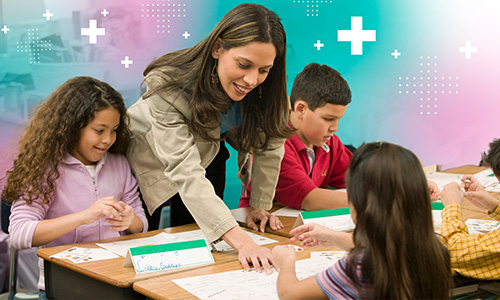
Is it just me, or does teaching math feels like taking students on a daily field trip to a different part of their brain?
It turns out this feeling is supported by science. While language processing occurs in only the left temporal lobe, mathematical thinking “occurs in the frontal, parietal, occipital and temporal lobes of both left and right hemispheres.” Whoa. That’s a lot of brain space!
So it’s less like taking a field trip than it is traversing a massive area of land. To students, perhaps that’s why it can feel exhilarating and exhausting, triumphant and intimidating.
When it comes to math, teachers are the intrepid mountain guides, hauling gear and demystifying concepts, taking what feels scary and turning it into a panoramic view. This specific duty requires specific preparation. We’ve rounded up 16 math posts from Teach. Learn. Grow. that celebrate, elevate, and hydrate math teachers on their trek.
Preparing the gear: Meeting students at an equitable pace
Each student needs a different set of gear as they embark. Teachers meet new students with excitement and possibility, knowing that they are different from every year before. These posts offer insight into establishing a classroom with an eye on equity, inclusion, and meeting each student’s needs.
- “How to meet math students where they are”—Ensure that you learn your students fully, from wherever their previous math journey ended, to best lead them to their next mathematical summit.
- “How to engage the emergent bilingual students in your math classroom”—Math is a universal language yet still deserves a specifically engaged framework for our bilingual students. This post gives actionable advice for supporting their unique learning.
- “The mythical math gene: 5 ways to build growth mindset”—Revisit the idea of growth mindset with fresh eyes and specifically cultivate it for the math classroom.
- “5 patterns in math skills of new kindergarteners—and 4 ways to address them”—Our youngest students bring an unmatched exuberance for learning. This post is full of ideas for supporting our newest math mountain climbers.
- “11 resources to support unfinished math learning”—The pandemic isn’t the first reason a student’s learning might be interrupted, but it’s certainly the largest and perhaps most recent. Here are some ideas for getting students back on track without fear or panic.
Base camp: Conversations (about math) around the campfire
When a math class gathers around a fire, it should be talkative and curious. As teachers establish relationships with students and gear up for the hike ahead, these blog posts help boost rapport, trust, and conversations around math.
- “Engaging mathematical thinking through formative conversation starters”—Get students talking about math for deeper insight into how their brains process a concept.
- “Demystify student thinking about math”—Learn about formative conversation starters from two experts, and begin to picture how to use them in your classroom more concretely.
- “How would you talk about math, if the answer weren’t the focus?”—No one is worried about the “right answer” while they toast a marshmallow. This post explores how to host conversations that deliberately avoid the notion of “correct” answers.
- “3 ways to be a ‘math person’”—Step 1: Outlaw the phrase “I’m not a math person!” Read the whole post for more steps on redefining a healthier, more patient math identity.
Gaining altitude: Before it gets easier, it might be more strenuous
You know that moment during a hike where you wheeze, “Wait. This is hard”? That’s the moment you know you’re on the road to something good. Instead of pretending it’s easy, spending time on the harder parts of our mathematical learning journey can yield the most triumphant of results.
- “How to quell math fears (it’s easier than you think)”—A must-read for all math teachers (and maybe even students and their grown-ups), this blog post offers perspective from a math research specialist on math anxiety and how to create a calm, empowered approach to learning.
- “How to support math growth with differentiation and scaffolding”—This post offers a practical walk-through of “below,” “at,” and “above” grade-level curriculum resources and Monday-ready ideas to meet the needs of all your learners.
- “Embrace mistake making in math”—This post is full of practical advice on how we, as teachers, can adjust our language, exhibit behaviors, and establish a classroom culture that, dare we say it, celebrates the hard parts!
- “What’s wrong with tracking students by math ability?”—Not everything we experienced as students is still a pedagogical best-practice. Read this research-filled article on how schools are revisiting “leveled” math classrooms.
Summit: Reflections and thoughts, courtesy of a 360° view
You made it to the top. What’s next? The joy of teaching includes a built-in process of renewal, rejuvenation, and new ideas. With every year, we learn from the last one and continue refining our practices. And, of course, we never say no to a new trail.
- “How to use BUILD stations to boost learning in your elementary math classroom”—Ready to try a new math classroom strategy? These small group stations center student choice, differentiation, and individualized math identity.
- “Pointless points and plotless plots: The dangers of accelerating mathematics learning”—Just like our hike to the top, math isn’t a race. Stopping and enjoying a view is just as important as curiously going a mile deep on a single math concept. How can we help our students slow down and enjoy the journey?
- “MAP Growth and Reveal Math now work together to streamline instruction”—Here at NWEA, we are always searching for new peaks on the range of mathematical instruction. Make your Sunday differentiation prep easier with this new partnership. Let us help lighten your pack!







